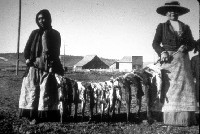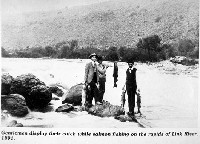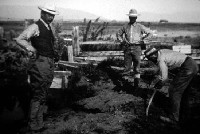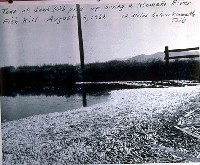| Area | Upper Klamath |
| Topic | Tour: Upper Klamath Historical Photos |
Klamath Tribe members relied in part on Lost River and short-nosed suckers for subsistence. Before the Klamath River was blocked by Copco Dam in 1918, Native Americans also harvested salmon from the Williamson and Sprague Rivers above Upper Klamath Lake. This photo provided by the Klamath Tribe.
Wooden drying racks were set up by members of the Klamath Tribe so that seasonal harvest of sucker fish or salmon could be dried and used for food through other seasons. Photo courtesy of the Bureau of Reclamation, Klamath Falls, Oregon.
Chinook salmon once made their way through Upper Klamath Lake and into the Sprague River to spawn. The large size, hooked jaw and V-shaped tails of these fish in this 1891 photo confirm that they are salmon. Salmon passage was blocked with the completion of Copco Dams in 1918. This photo was taken on a short reach of the Klamath known as Link River that connects Upper Klamath Lake with Lake Ewauna at the city of Klamath Falls. Photo courtesy of the Bureau of Reclamation, Klamath Falls, Oregon.
Early operations of the Klamath Project often involved manual labor with shovels to create ditches linking the canals to fields. The Klamath Project is one of the nation's oldest and was completed in 1905. Photo courtesy of the Bureau of Reclamation, Klamath Falls, Oregon.
The photo above shows a major fish kill on the Klamath River between Lake Ewauna and Keno, Oregon in 1966. A major effort was launched in this period to clean up the river, specifically by improving sewage treatment at the city of Klamath Falls and by reducing log storage in rafts on the river in this reach. Photo provided by Lewis Furber.
 Click on image to enlarge (44K).
Click on image to enlarge (44K). Click on image to enlarge (62K).
Click on image to enlarge (62K). Click on image to enlarge (52K).
Click on image to enlarge (52K). Click on image to enlarge (37K).
Click on image to enlarge (37K). Click on image to enlarge (61K).
Click on image to enlarge (61K).
To learn more about this topic click Info Links
To view additional information (data source, aquisition date etc.) about this page, click Metadata
| www.krisweb.com |
